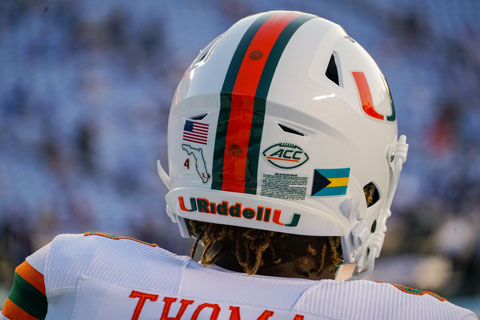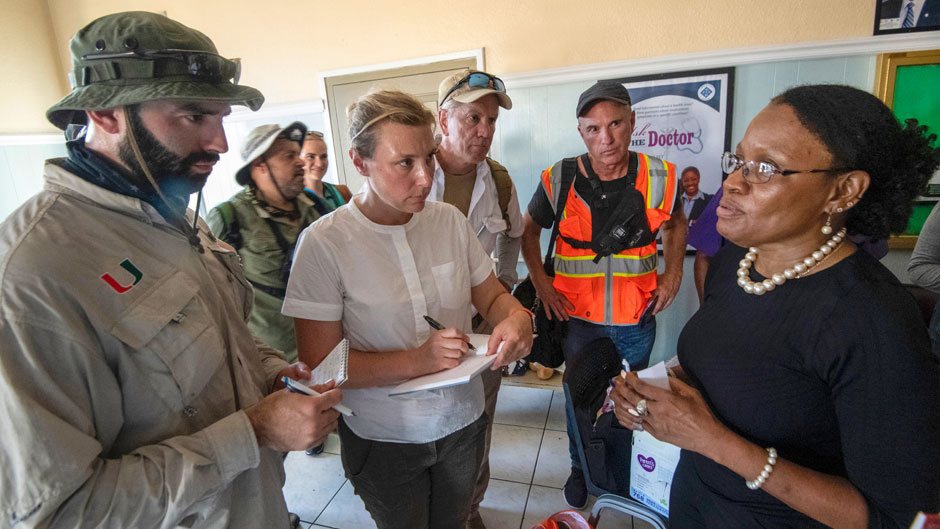As the Cessna 2088 Grand Caravan single engine turboprop descended on the airport in Freeport, the passengers got their first glimpse of areas in the Bahamas hit by Hurricane Dorian.
On the side of the air strip, planes were scattered like toy models, noses punched and propellers bent. Trees stood as naked sentinels unbowed in the scorching sunlight, leaves and branches stripped from their thick trunks. In the distance, buildings were reduced to piles of rubble and slabs of broken concrete.
On board, a small team from the University of Miami took in the view. They arrived for the first time last Friday afternoon, their mission to assess the health and hospital needs of the Bahamian people after meeting with administrators at two hospitals in Freeport, the Rand Memorial Hospital and the Sunrise Medical Center. They returned on Monday, continuing their assessment and taking valuable notes that will help determine the full response of the University’s medical and nursing teams to the dire situation on the islands located about 100 miles from Miami.
Dr. Elizabeth Greig, now an internist who as a medical student coordinated patient care during the University’s response following the devastating earthquake that struck Port-au-Prince, Haiti, in January 2010, spoke about the potential needs of the Bahamian people and the value of the University’s health care operation to the neighboring country.
“We need to determine how can we best as a University provide aid that is meaningful, important and complements that from all the other relief operations there,” Greig said Friday, standing in 90 degree-plus heat at the International Flight Center at the Miami Executive Airport on the edge of the Everglades. “It’s really essential that we do not interfere with the first responders. You have to figure out how best your organization can help.”
More than 100 doctors at the Miller School of Medicine and UHeath have offered to volunteer. Faculty and students with the School of Nursing and Health Studies are ready to deploy as soon as the scope of the mission is firmed up.
While the logistics progress, the University is taking other steps to help the victims of Hurricane Dorian, many of them most likely descendants of Bahamians who settled in South Florida in the late 1800s and played an integral role in developing much of Miami’s initial infrastructure of roadways, railroads, and bridges.
The University launched “The U Responds: Hurricane Dorian Response Fund,” to help Bahamians and others along the U.S. Atlantic coastal region impacted by Dorian. Student organizations, including the Bahamian Student Organization, are collecting supplies to send to the islands. Other individual efforts are also underway. There are about 18 Bahamian students on campus, and nearly two dozen faculty and staff who identified as being from the islands.
Provost Jeffrey Duerk said the University has reached out to the University of the Bahamas to see what assistance it needs. The main campus in Nassau was not impacted, and it has a smaller operation in Freeport on Grand Bahama. The University of Miami will respond accordingly, he said.

Last Saturday, for its game against the University of North Carolina, the Hurricanes football team wore helmets with a blue and yellow Bahamian flag decal in the right back area. It was the idea of football head coach Manny Diaz to show solidarity with the islands.
On Friday at the Miami Executive Airport, Greig was accompanied by Vincent J. Torres, emergency manager with the Miller School of Medicine and the UHealth system, Tom Koulouris, an engineer who helped build UM’s temporary emergency hospital in Haiti after the earthquake and is an adjunct lecturer in the College of Engineering, and others working for nonprofit relief agencies. Around them, workers with local nonprofit organizations huddled in hangers and packed bags with supplies for the hurricane survivors.
The needs of the victims will intensify as time goes on, Greig said. Wound infection, vector borne disease, and illnesses associated with poor sanitary conditions are all likely to occur.
“We are going to see an onslaught of complications,” she said.

